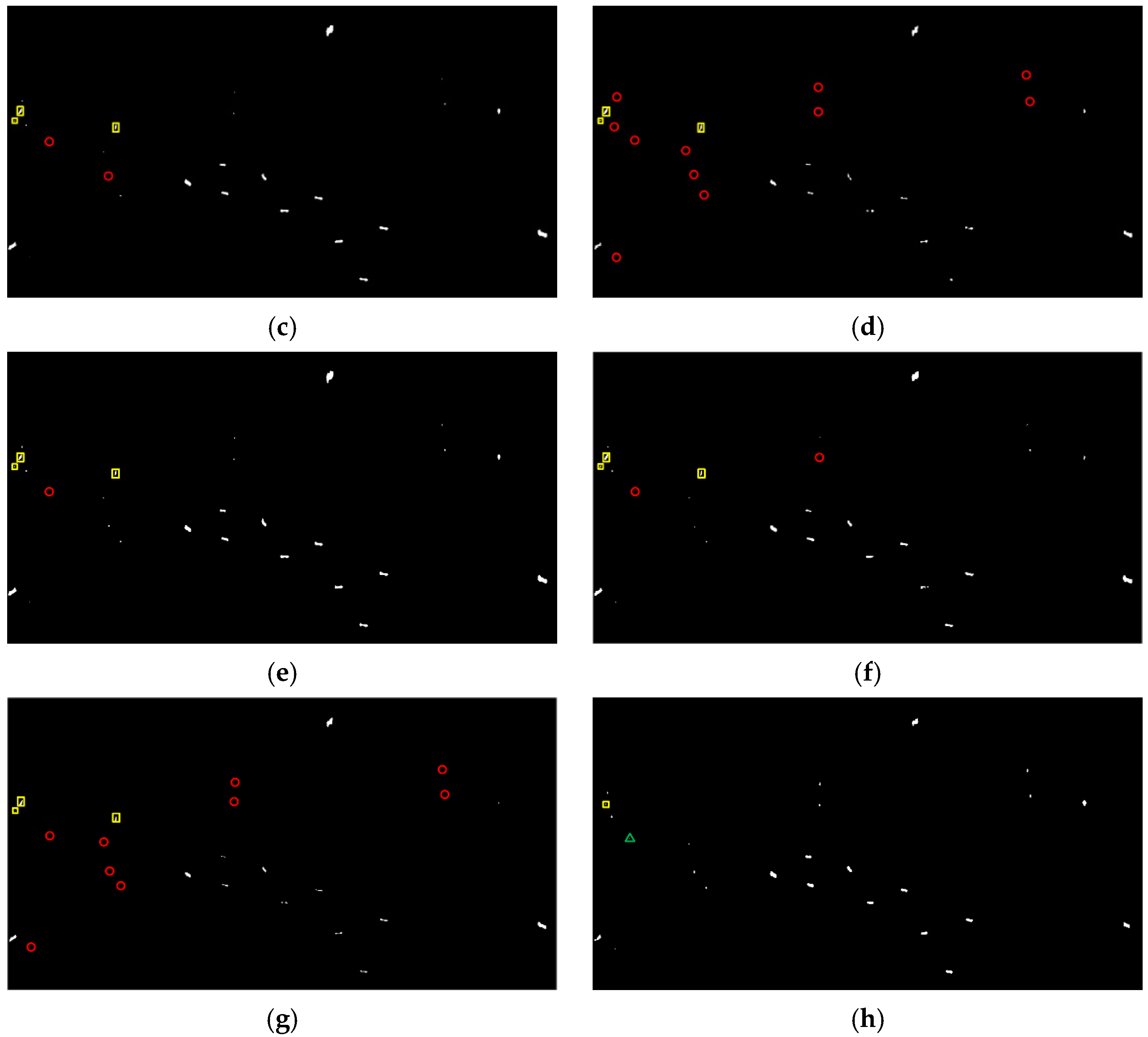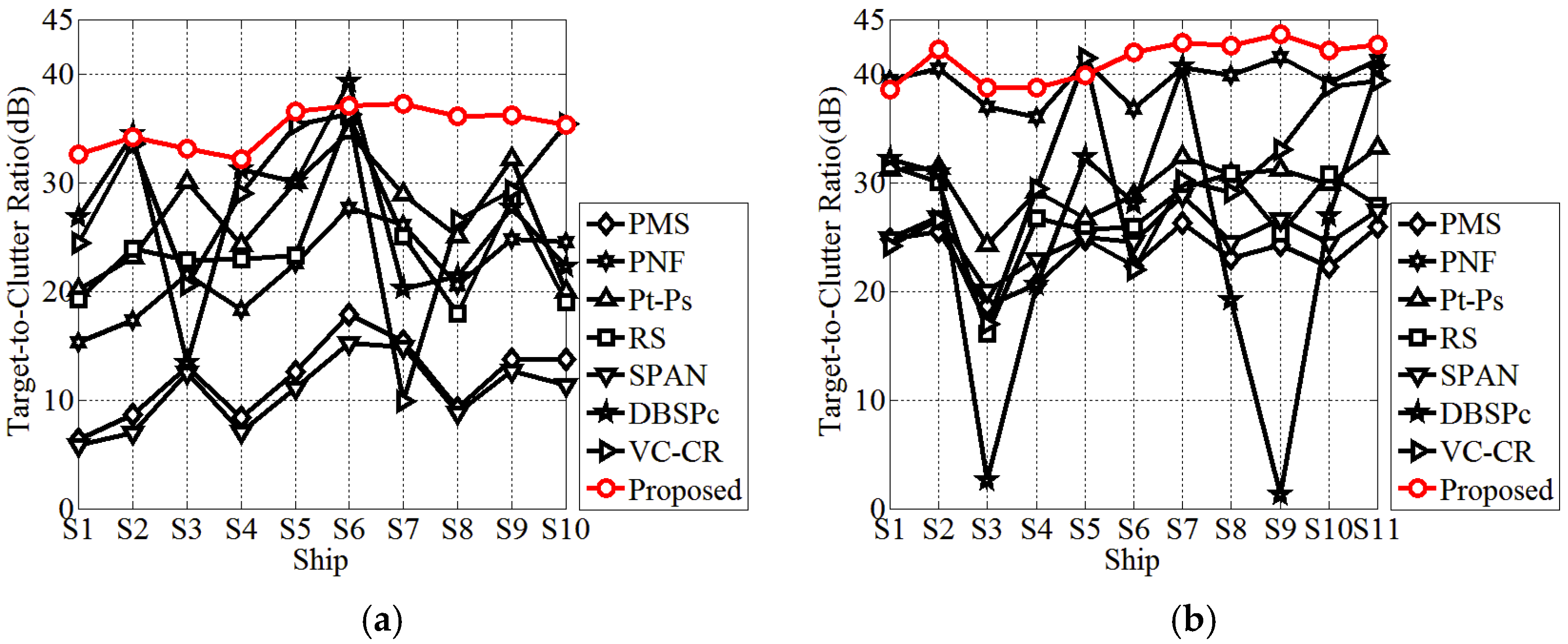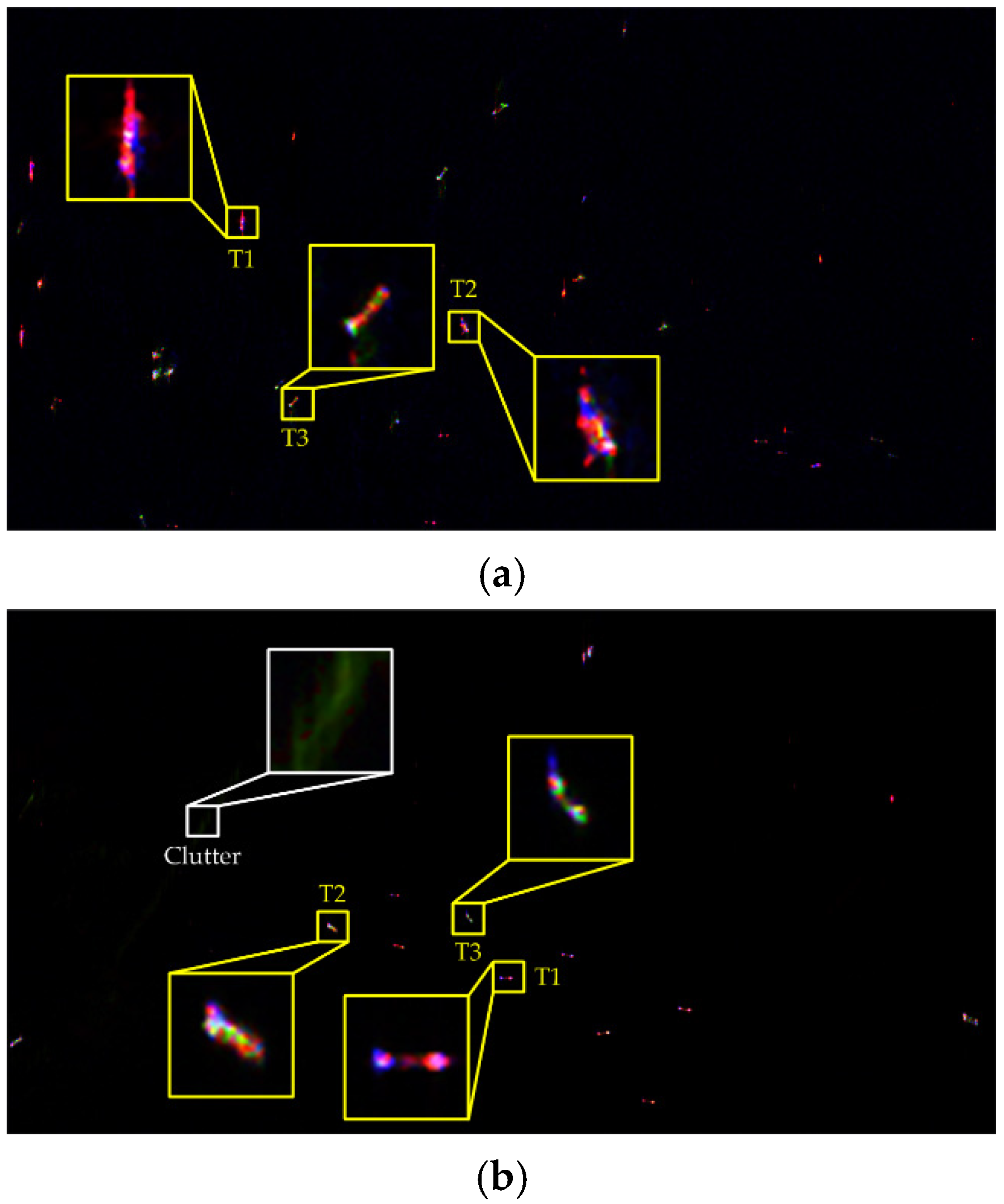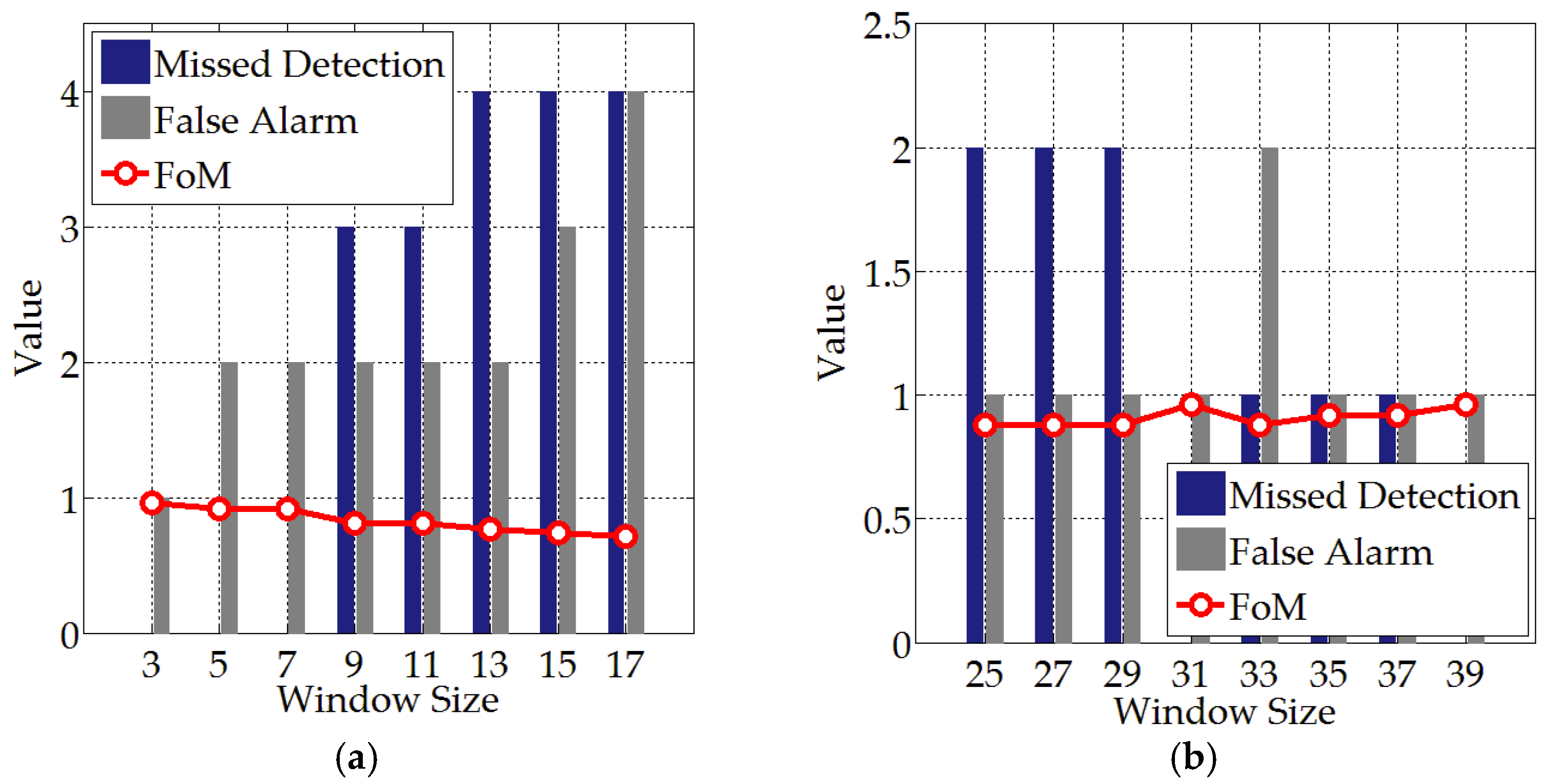Integration of Fine Model-Based Decomposition and Guard Filter for Ship Detection in PolSAR Images
Abstract
:1. Introduction
2. Methodology
2.1. Advanced Physical Scattering Models
2.2. Eight-Component Model-Based Decomposition
2.3. Detection Feature Construction
2.4. Guard Filter-Based Ship Detector
3. Experimental Results
3.1. Datasets
3.2. Detection Performance and Comparison
4. Discussion
4.1. Performance of the Proposed Decomposition
4.2. Window Parameter Test
5. Conclusions
Author Contributions
Funding
Institutional Review Board Statement
Informed Consent Statement
Data Availability Statement
Conflicts of Interest
References
- Lee, J.S.; Pottier, E. Polarimetric Radar Imaging: From Basics to Applications; Taylor & Francis: Boca Raton, FL, USA, 2009; pp. 85–158. ISBN 9781420054972. [Google Scholar]
- Marino, A.; Cloude, S.R.; Woodhouse, I.H. Detecting Depolarized Targets Using a New Geometrical Perturbation Filter. IEEE Trans. Geosci. Remote Sens. 2012, 50, 3787–3799. [Google Scholar] [CrossRef] [Green Version]
- Chaney, R.D.; Bud, M.C.; Novak, L.M. On the performance of polarimetric target detection algorithms. IEEE Trans. Aerosp. Electron. Syst. 1990, 5, 10–15. [Google Scholar] [CrossRef]
- Liu, T.; Zhang, J.; Gao, G.; Yang, J.; Marino, A. CFAR Ship Detection in Polarimetric Synthetic Aperture Radar Images Based on Whitening Filter. IEEE Trans. Geosci. Remote Sens. 2020, 58, 58–81. [Google Scholar] [CrossRef]
- Liu, T.; Yang, Z.; Yang, J.; Gao, G. CFAR Ship Detection Methods Using Compact Polarimetric SAR in a K-Wishart Distribution. IEEE J. Sel. Top. Appl. Earth Obs. Remote Sens. 2019, 12, 3737–3745. [Google Scholar] [CrossRef]
- Fan, W.; Zhou, F.; Bai, X.; Tao, M.; Tian, T. Ship Detection Using Deep Convolutional Neural Networks for PolSAR Images. Remote Sens. 2019, 11, 2862. [Google Scholar] [CrossRef] [Green Version]
- Zhang, X.; Zhang, T.; Shi, J.; Shunjun, W. High speed and high-accurate SAR ship detection based on a depthwise separable convolution neural network. J. Radars 2019, 8, 841–851. [Google Scholar] [CrossRef]
- Jin, K.; Chen, Y.; Xu, B.; Yin, J.; Wang, X.; Yang, J. A Patch-to-Pixel Convolutional Neural Network for Small Ship Detection with PolSAR Images. IEEE Trans. Geosci. Remote Sens. 2020, 58, 6623–6638. [Google Scholar] [CrossRef]
- Novak, L.; Sechtin, M.; Cardullo, M. Studies of target detection algorithms that use polarimetric radar data. IEEE Trans. Aerosp. Electron. Syst. 1989, 25, 150–165. [Google Scholar] [CrossRef] [Green Version]
- De Graff, S.R. SAR Image Enhancement via Adaptive Polarization Synthesis and Polarimetric Detection Performance. In Proceedings of the Polarimetry Technology Workshop, Redstone Arsenal, AL, USA, 16–18 August 1988. [Google Scholar]
- Velotto, D.; Nunziata, F.; Migliaccio, M.; Lehner, S. Dual-Polarimetric TerraSAR-X SAR Data for Target at Sea Observation. IEEE Geosci. Remote Sens. Lett. 2013, 10, 1114–1118. [Google Scholar] [CrossRef]
- Sugimoto, M.; Ouchi, K.; Nakamura, Y. On the novel use of model-based decomposition in SAR polarimetry for target detection on the sea. Remote Sens. Lett. 2013, 4, 843–852. [Google Scholar] [CrossRef]
- Zhang, T.; Ji, J.; Li, X.; Yu, W.; Xiong, H. Ship Detection From PolSAR Imagery Using the Complete Polarimetric Covariance Difference Matrix. IEEE Trans. Geosci. Remote Sens. 2018, 57, 2824–2839. [Google Scholar] [CrossRef]
- Wei, J.; Zhang, J.; Huang, G.; Zhao, Z. On the Use of Cross-Correlation between Volume Scattering and Helix Scattering from Polarimetric SAR Data for the Improvement of Ship Detection. Remote Sens. 2016, 8, 74. [Google Scholar] [CrossRef] [Green Version]
- Marino, A. A Notch Filter for Ship Detection with Polarimetric SAR Data. IEEE J. Sel. Top. Appl. Earth Obs. Remote Sens. 2013, 6, 1219–1232. [Google Scholar] [CrossRef] [Green Version]
- Lee, J.-S.; Ainsworth, T.L.; Wang, Y. Generalized Polarimetric Model-Based Decompositions Using Incoherent Scattering Models. IEEE Trans. Geosci. Remote Sens. 2013, 52, 2474–2491. [Google Scholar] [CrossRef]
- Chen, S.-W.; Wang, X.-S.; Xiao, S.-P.; Sato, M. General Polarimetric Model-Based Decomposition for Coherency Matrix. IEEE Trans. Geosci. Remote Sens. 2014, 52, 1843–1855. [Google Scholar] [CrossRef]
- Zhang, L.; Zou, B.; Cai, H.; Zhang, Y. Multiple-Component Scattering Model for Polarimetric SAR Image Decomposition. IEEE Geosci. Remote Sens. Lett. 2008, 5, 603–607. [Google Scholar] [CrossRef]
- Quan, S.; Xiang, D.; Xiong, B.; Hu, C.; Kuang, G. A Hierarchical Extension of General Four-Component Scattering Power Decomposition. Remote Sens. 2017, 9, 856. [Google Scholar] [CrossRef] [Green Version]
- Sato, A.; Yamaguchi, Y.; Singh, G.; Park, S.-E. Four-Component Scattering Power Decomposition with Extended Volume Scattering Model. IEEE Geosci. Remote Sens. Lett. 2012, 9, 166–170. [Google Scholar] [CrossRef]
- Quan, S.; Qin, Y.; Xiang, D.; Wang, W.; Wang, X. Polarimetric Decomposition-Based Unified Manmade Target Scattering Characterization With Mathematical Programming Strategies. IEEE Trans. Geosci. Remote Sens. 2021, 1–18. [Google Scholar] [CrossRef]
- Xiang, D.; Ban, Y.; Su, Y. Model-Based Decomposition With Cross Scattering for Polarimetric SAR Urban Areas. IEEE Geosci. Remote Sens. Lett. 2015, 12, 2496–2500. [Google Scholar] [CrossRef]
- Xi, Y.; Lang, H.; Tao, Y.; Huang, L.; Pei, Z. Four-Component Model-Based Decomposition for Ship Targets Using PolSAR Data. Remote Sens. 2017, 9, 621. [Google Scholar] [CrossRef] [Green Version]
- Singh, G.; Malik, R.; Mohanty, S.; Rathore, V.; Yamada, K.; Umemura, M.; Yamaguchi, Y. Seven-Component Scattering Power Decomposition of POLSAR Coherency Matrix. IEEE Trans. Geosci. Remote Sens. 2019, 57, 8371–8382. [Google Scholar] [CrossRef]
- Singh, G.; Mohanty, S.; Yamazaki, Y.; Yamaguchi, Y. Physical Scattering Interpretation of POLSAR Coherency Matrix by Using Compound Scattering Phenomenon. IEEE Trans. Geosci. Remote Sens. 2020, 58, 2541–2556. [Google Scholar] [CrossRef]
- Yamaguchi, Y.; Moriyama, T.; Ishido, M.; Yamada, H. Four-component scattering model for polarimetric SAR image decomposition. IEEE Trans. Geosci. Remote Sens. 2005, 43, 1699–1706. [Google Scholar] [CrossRef]
- Freeman, A.; Durden, S. A three-component scattering model for polarimetric SAR data. IEEE Trans. Geosci. Remote Sens. 1998, 36, 963–973. [Google Scholar] [CrossRef] [Green Version]
- Quan, S.; Xiong, B.; Xiang, D.; Kuang, G. Derivation of the Orientation Parameters in Built-Up Areas: With Application to Model-Based Decomposition. IEEE Trans. Geosci. Remote Sens. 2018, 56, 4714–4730. [Google Scholar] [CrossRef]
- Cloude, S.R. Polarisation: Applications in Remote Sensing; Oxford University Press: New York, NY, USA, 2010; pp. 57–65. ISBN 9780191574382. [Google Scholar]
- Xiang, D.; Tang, T.; Hu, C.; Fan, Q.; Su, Y. Built-up area extraction from PolSAR imagery with model-based decomposition and polarimetric coherence. Remote Sens. 2016, 8, 685. [Google Scholar] [CrossRef] [Green Version]
- Quan, S.; Xiong, B.; Xiang, D.; Zhao, L.; Zhang, S.; Kuang, G. Eigenvalue-Based Urban Area Extraction Using Polarimetric SAR Data. IEEE J. Sel. Top. Appl. Earth Obs. Remote Sens. 2018, 11, 458–471. [Google Scholar] [CrossRef]
- Zhang, T.; Jiang, L.; Xiang, D.; Ban, Y.; Pei, L.; Xiong, H. Ship detection from PolSAR imagery using the ambiguity removal polarimetric notch filter. ISPRS J. Photogramm. Remote Sens. 2019, 157, 41–58. [Google Scholar] [CrossRef]
- Liu, G.; Zhang, X.; Meng, J. A Small Ship Target Detection Method Based on Polarimetric SAR. Remote Sens. 2019, 11, 2938. [Google Scholar] [CrossRef] [Green Version]
- Chen, S.-W.; Ohki, M.; Shimada, M.; Sato, M. Deorientation Effect Investigation for Model-Based Decomposition Over Oriented Built-Up Areas. IEEE Geosci. Remote Sens. Lett. 2013, 10, 273–277. [Google Scholar] [CrossRef]









| Data | Method | |||||
|---|---|---|---|---|---|---|
| GF3 | PMS | 49 | 41 | 8 | 2 | 0.80 |
| PNF | 42 | 7 | 7 | 0.75 | ||
| Pt-Ps | 44 | 5 | 1 | 0.88 | ||
| RS | 41 | 8 | 5 | 0.76 | ||
| SPAN | 40 | 9 | 6 | 0.73 | ||
| DBSPc | 46 | 3 | 4 | 0.87 | ||
| VC-CR | 45 | 4 | 4 | 0.85 | ||
| Proposed | 49 | 0 | 2 | 0.96 | ||
| AIRSAR | PMS | 24 | 22 | 2 | 5 | 0.76 |
| PNF | 22 | 2 | 2 | 0.85 | ||
| Pt-Ps | 21 | 3 | 2 | 0.81 | ||
| RS | 13 | 11 | 3 | 0.48 | ||
| SPAN | 23 | 1 | 3 | 0.88 | ||
| DBSPc | 22 | 2 | 3 | 0.81 | ||
| VC-CR | 15 | 9 | 3 | 0.56 | ||
| Proposed | 24 | 0 | 1 | 0.96 |
| GF3 Data | AIRSAR Data | |||||
|---|---|---|---|---|---|---|
| T1 | T2 | T3 | T1 | T2 | T3 | |
| Surface scattering | 17.52% | 28.13% | 12.09% | 28.37% | 23.41% | 27.84% |
| Double-bounce scattering | 78.67% | 53.34% | 33.74% | 62.00% | 26.20% | 11.50% |
| Volume scattering | 2.98% | 12.15% | 28.65% | 8.49% | 28.49% | 34.43% |
| Helix scattering | 0.74% | 4.60% | 9.71% | 0.93% | 12.75% | 10.24% |
| Cross scattering | 0.03% | 0.37% | 4.93% | 0.00% | 1.86% | 3.08% |
| ±45° OD scattering | 0.04% | 0.87% | 4.07% | 0.00% | 3.34% | 7.32% |
| ±45° OQW scattering | 0.02% | 0.48% | 4.61% | 0.21% | 3.69% | 5.59% |
| MD scattering | 0.00% | 0.06% | 2.19% | 0.00% | 0.26% | 0.00% |
| Ship scattering | 79.50% | 59.73% | 59.25% | 63.14% | 48.10% | 37.73% |
Publisher’s Note: MDPI stays neutral with regard to jurisdictional claims in published maps and institutional affiliations. |
© 2021 by the authors. Licensee MDPI, Basel, Switzerland. This article is an open access article distributed under the terms and conditions of the Creative Commons Attribution (CC BY) license (https://creativecommons.org/licenses/by/4.0/).
Share and Cite
Liu, D.; Han, L. Integration of Fine Model-Based Decomposition and Guard Filter for Ship Detection in PolSAR Images. Sensors 2021, 21, 4295. https://doi.org/10.3390/s21134295
Liu D, Han L. Integration of Fine Model-Based Decomposition and Guard Filter for Ship Detection in PolSAR Images. Sensors. 2021; 21(13):4295. https://doi.org/10.3390/s21134295
Chicago/Turabian StyleLiu, Dongsheng, and Ling Han. 2021. "Integration of Fine Model-Based Decomposition and Guard Filter for Ship Detection in PolSAR Images" Sensors 21, no. 13: 4295. https://doi.org/10.3390/s21134295





